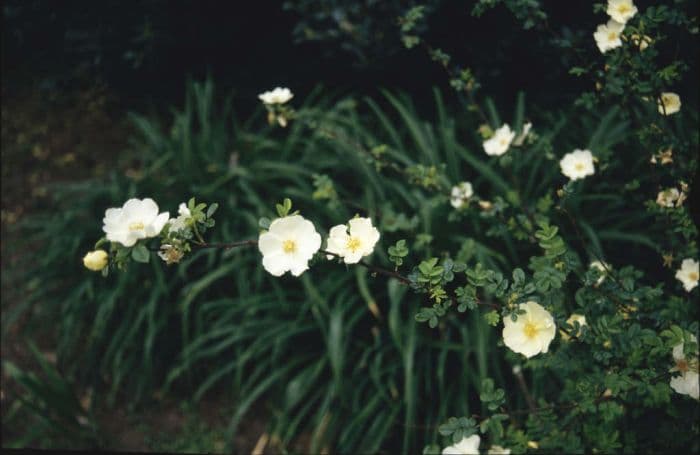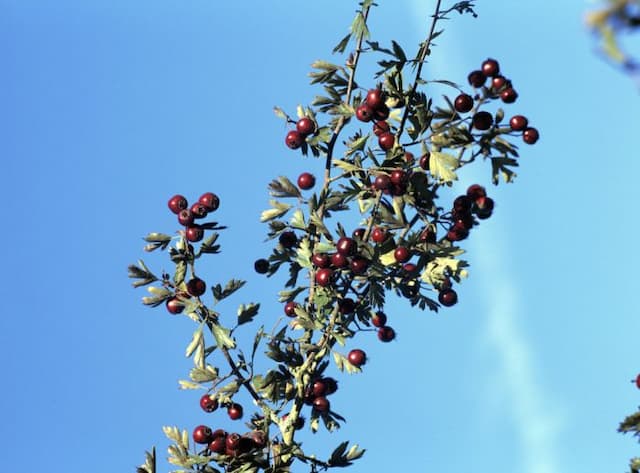Cambridge Rose Rosa 'Cantabrigiensis' (S)

ABOUT
The Rosa 'Cantabrigiensis', also commonly known as the Cambridge Rose, is a picturesque flowering shrub that is renowned for its striking appearance. This variety produces a cascade of creamy yellow flowers that are visually soft and inviting. The blooms are generally flat or cupped in shape, carrying a gentle allure that can enliven any garden setting. Each flower, delicately arranged in clusters, exhibits a symphony of petals that tend to sport a pale yellow hue, sometimes manifesting with slightly deeper tones at the center, and gradually fading to an alabaster or ivory shade toward the edges. The foliage of the Cambridge Rose is also quite notable, typically dark green in color and providing a lush backdrop for the luminous flowers. The leaves exhibit a glossy sheen and are comprised of smaller leaflets that are neatly arranged along the stems. This creates a dense, leafy habit that contributes to the overall aesthetic charm of the shrub. Throughout the plant, the stems may showcase an array of small thorns or prickles, which is characteristic of rose plants in general. As the seasons progress, the Cambridge Rose transitions through phases of growth and dormancy, with its flowers blooming mainly in the spring or early summer, and sometimes repeating their show later in the season. The blooms also attract an array of pollinators such as bees and butterflies, adding to the dynamic environment of the garden. Overall, the Cambridge Rose brings with it a traditional, yet timeless elegance that can be appreciated in various landscape settings.
About this plant
 Names
NamesFamily
Rosaceae
Synonyms
Cambridge Rose, Cantabrigiensis Rose
Common names
Rosa 'Cantabrigiensis'
 Toxicity
ToxicityTo humans
The plant commonly known as the Cambridge rose (Rosa 'Cantabrigiensis') is not considered toxic to humans. Roses, in general, are not poisonous and no severe symptoms of poisoning should be expected upon ingesting parts of this plant. However, caution should be taken due to the presence of thorns which can cause physical injury.
To pets
Cambridge rose (Rosa 'Cantabrigiensis') is not known to be toxic to pets. Similar to its effects on humans, ingestion of the rose petals or leaves is unlikely to result in poisoning. Nevertheless, pets should be discouraged from eating roses to prevent potential gastrointestinal upset or injury from the thorns.
 Characteristics
CharacteristicsLife cycle
Perennials
Foliage type
Deciduous
Color of leaves
Green
Flower color
Pale yellow
Height
5 feet (1.52 meters)
Spread
5 feet (1.52 meters)
Plant type
Shrub
Hardiness zones
5
Native area
Cultivar
Benefits
 General Benefits
General Benefits- Enhancing Aesthetics: The Rosa 'Cantabrigiensis' (Cambridge Rose) adds beauty to gardens with its pale-yellow or cream-colored flowers that make it an attractive ornamental plant.
- Attracting Pollinators: The flowers are known to attract bees, butterflies, and other beneficial pollinators, which can help increase the pollination of nearby plants.
- Creating Habitats: It provides shelter and breeding places for various small wildlife, promoting biodiversity in the garden.
- Erosion Control: The shrub can help stabilize soil in the garden or landscape, preventing erosion by wind and water.
- Low Maintenance: The Cambridge Rose is known for being a low-maintenance plant requiring minimal care once established, which is ideal for busy gardeners or those seeking hardy plant species.
- Shade Tolerance: This rose variety is capable of growing in areas with partial shade, offering flexibility in garden design and plant placement.
- Hedging and Borders: It can be used to create natural hedges or borders in a garden landscape, providing structure and form to garden spaces.
- Seasonal Interest: The Cambridge Rose provides seasonal interest with its spring and summer blooms, followed by sometimes colorful hips in the autumn.
- Cultural Significance: Roses have a long history of horticultural interest and cultural significance, making them a timeless addition to any garden with historical or traditional design elements.
- Variety of Uses: This rose can be used in diverse ways such as in beds, borders, containers, or even as ground cover, depending on pruning and maintenance.
 Medical Properties
Medical Properties- This plant is not used for medical purposes.
 Air-purifying Qualities
Air-purifying QualitiesThis plant is not specifically known for air purifying qualities.
 Other Uses
Other Uses- Rosa 'Cantabrigiensis' petals can be used to create natural dyes for fabrics, offering a range of colors from soft pinks to rich yellows depending on the mordant used.
- The rose hips, the fruit of Rosa 'Cantabrigiensis', can be used to make botanical jewelry, such as necklaces and earrings, after drying and treating them.
- Petals of Rosa 'Cantabrigiensis' serve as edible decorations for pastries and desserts, adding a hint of color and a mild floral flavor.
- Dried petals of this rose can be incorporated into homemade potpourri mixes, contributing to a pleasant and natural fragrance for indoor spaces.
- Rosa 'Cantabrigiensis' petals can be used in the craft of flower pounding, where the pigments are transferred onto fabric or paper to make artistic prints.
- The thorns of Rosa 'Cantabrigiensis' can be carefully harvested and used as natural needles or pins in traditional crafting practices.
- This rose can be used in perfumery to capture the essence of its fragrance in handmade perfumes, oils, or scented waters.
- Leaves of the Rosa 'Cantabrigiensis' can be used as a natural insect repellent when crushed and rubbed onto skin or clothing.
- The plant can be trained to grow along trellises or arches to serve as a living privacy screen or garden divider due to its dense foliage.
- Rose petals from Rosa 'Cantabrigiensis' can be used in the tradition of flower reading, where different flowers and their arrangements are interpreted to deliver messages or predict future events.
Interesting Facts
 Feng Shui
Feng ShuiThe Cambridge rose is not used in Feng Shui practice.
 Zodiac Sign Compitability
Zodiac Sign CompitabilityThe Cambridge rose is not used in astrology practice.
 Plant Symbolism
Plant Symbolism- Love: As a variety of rose, Rosa 'Cantabrigiensis' inherently symbolizes love. Roses are one of the most iconic symbols for deep affection and romantic emotions.
- Beauty: The exquisite form and color of the Rosa 'Cantabrigiensis' flowers represent beauty and perfection, reflecting an aesthetic charm that is often associated with roses.
- Honor: Giving a rose is a gesture of respect and admiration, tying to the symbolism of honor that has been associated with this flower through the ages.
- Devotion: The rose, with its intricate layers and long-standing connection to romantic sentiments, often signifies deep devotion and commitment.
- Secrecy: Historically, the rose was a symbol of secrecy. A rose hanging over a meeting table indicated that the matters discussed should remain confidential, hence the phrase "sub rosa" (under the rose).
 Water
WaterThe Cambridge Rose should be watered deeply once a week, with adjustments made for rainfall and climate conditions. To ensure the soil is thoroughly moistened, use about 1 to 1.5 gallons of water per plant for each watering session. During hot or dry periods, the frequency may need to increase to twice per week. It's important to avoid overhead watering to prevent disease; instead, water at the base of the plant. During the winter, reduce watering as the plant goes dormant, ensuring the soil doesn't completely dry out.
 Light
LightThe Cambridge Rose thrives in full sunlight, requiring at least six hours of direct sun daily to perform best. Place the plant in a location where it receives ample morning light, which helps to dry dew on the leaves and prevent fungal diseases. Partial shade is tolerated, especially in regions with very hot afternoons, but too much shade can lead to poor blooming and a leggy growth habit.
 Temperature
TemperatureThe Cambridge Rose prefers a temperate range, thriving in USDA zone 5 through 9, which generally means it can survive minimum temperatures down to -20°F and maximum temperatures well above 90°F. The ideal growing temperature for this rose is between 65°F and 75°F. To ensure robust growth and flowering, it's crucial to protect the plant from extreme cold by providing winter mulch in colder zones.
 Pruning
PruningPruning the Cambridge Rose is essential to maintain health, shape, and prolific blooming. Prune annually in early spring by removing dead or damaged wood and thinning out crowded branches to increase air circulation. Aim to cut back about one-third of the previous year's growth to promote vigorous new shoots. The best time for substantial pruning is when the plant is still dormant before new leaves emerge.
 Cleaning
CleaningAs needed
 Soil
SoilThe Cambridge Rose thrives in well-draining loamy soil with a mix of two parts garden soil, one part compost or well-rotted manure, and one part sand or perlite. An ideal soil pH for Rosa 'Cantabrigiensis' is between 6.5 and 7.0, slightly acidic to neutral.
 Repotting
RepottingCambridge Rose, typically grown outdoors, doesn't require frequent repotting. In containers, repot once every 2 to 3 years, early spring before new growth starts is ideal.
 Humidity & Misting
Humidity & MistingThe Cambridge Rose prefers average outdoor humidity levels and does not require specific humidity adjustments, making it adaptable to most garden environments.
 Suitable locations
Suitable locationsIndoor
Difficult indoors; needs sunlight, cool temps.
Outdoor
Plant in sun, fertile soil, water regularly.
Hardiness zone
5-9 USDA
 Life cycle
Life cycleRosa 'Cantabrigiensis', also known as the Cambridge Rose, starts its life as a seed, which after a period of dormancy, often requiring stratification, germinates typically in spring when conditions are favorable. The seedling emerges and establishes itself, growing into a young plant through vegetative growth, developing leaves, and a root system to absorb water and nutrients. As the plant matures, it enters the vegetative stage where it continues to grow and produce more leaves and stems. Following the vegetative state, the Cambridge Rose enters the flowering stage, typically in late spring to early summer, producing fragrant yellow flowers that attract pollinators. After pollination, the flowers develop into fruit, technically known as hips, which contain seeds for the next generation. The plant may enter a period of dormancy during the cold winter months, only to restart its growth cycle with the return of warmer spring temperatures.
 Propogation
PropogationPropogation time
Spring-early summer
The most popular method of propagation for the Rose 'Cantabrigiensis' is through hardwood cuttings. This is typically done during the dormant season, which is in late fall or winter. To propagate, a gardener would select a healthy, mature stem from the rose bush and cut a piece that is about 6 to 8 inches (15 to 20 centimeters) long. The cutting should have several nodes, where leaves and buds emerge. After making a clean cut at the base on a slight angle just below a node, the lower leaves are removed, and the cut end is often dipped in rooting hormone to encourage root development. The prepared cutting is then planted in a pot filled with a mixture of sand and peat or a well-draining soil mix, with the bottom two-thirds of the cutting buried. It's essential to keep the cutting moist and in indirect light until roots have formed, which can take several weeks or more.









